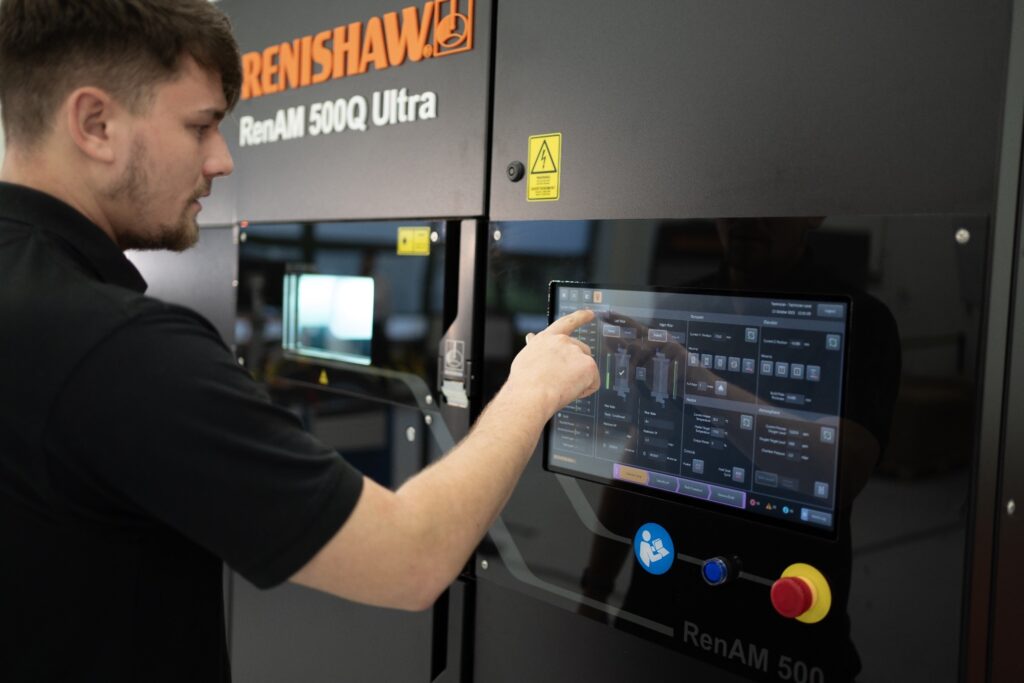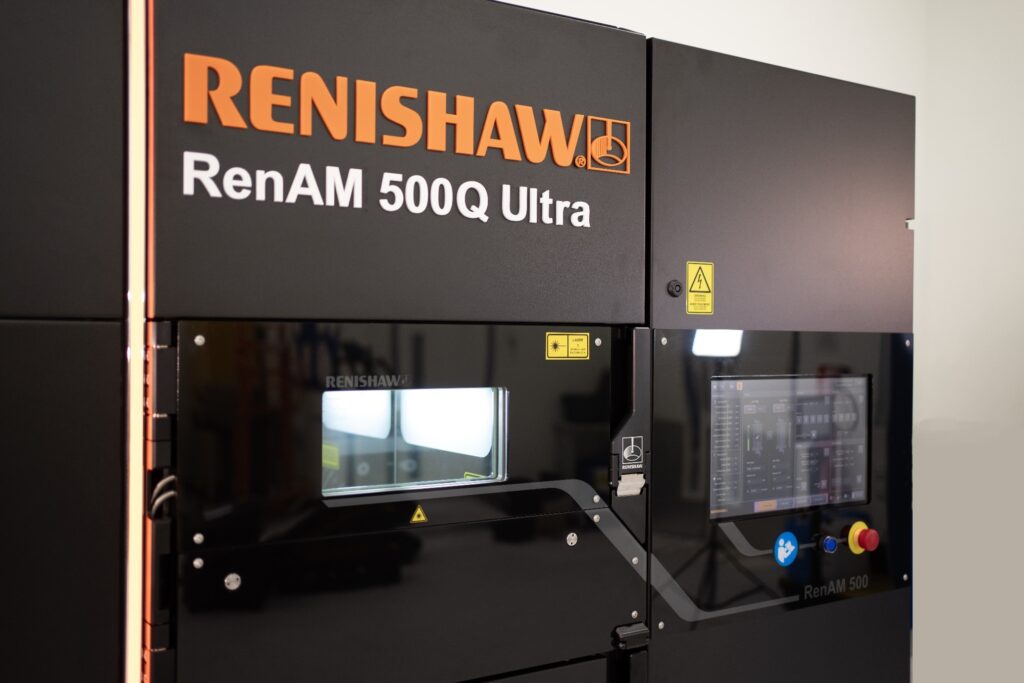Renishaw has made a significant leap in metal additive manufacturing (AM) with the launch of its TEMPUS technology at Formnext 2023. This innovative approach, now a standard feature in the new RenAM 500 Ultra system that was also showcased at the event, has been shown to cut build times by up to 50 percent without compromising the quality of parts.
TEMPUS Doubles Print Efficiency
TEMPUS technology stands out in the metal powder bed fusion (PBF) segment. Unlike conventional methods where powder recoating must be completed before layer consolidation, TEMPUS allows the lasers to operate in tandem with recoating. This synchronization, facilitated by a blend of sophisticated software and hardware, effectively shaves off up to nine seconds per layer, amounting to a substantial reduction in hours for the entire build process.
TEMPUS technology employs sophisticated scanning algorithms to order the data for each layer, enhancing the efficiency of the build process without compromising the quality of the final part. This optimization is particularly advantageous for certain shapes and designs, although improvements can be seen across all types of part geometries. This makes it particularly beneficial for parts with specific features, like thin, vertical walls, which see notable improvements in build speed.
Metal component specialist Alloyed has been using TEMPUS technology since 2021 for consumer electronics and computing, with Renishaw maintaining an exclusive partnership agreement.
The RenAM 500 Ultra
While TEMPUS comes standard on the new RenAM 500 Ultra 3D printer, unveiled at Formnext, Renishaw customers can also upgrade their existing RenAM 500 series machines to feature TEMPUS. The RenAM 500 Ultra not only harnesses the TEMPUS technology but also incorporates Renishaw’s advanced process monitoring software, offering users detailed build analytics and in-process visibility.
Complementing the optical systems, chamber, gas flow and other design elements of the RenAM 500 series, the Ultra edition also streamlines powder and waste management for high-volume production. Available in configurations with one or four lasers, the RenAM 500 Ultra ensures comprehensive coverage of the powder bed, leading to faster build rates and lower costs per part.
“Reducing cost per part is critical to the wider adoption of AM technology,” explained Louise Callanan, Director of Additive Manufacturing at Renishaw. “The dominant contributing factor to part cost for most components today is the time spent building the part on the machine itself. Reducing the amount of machine time per part therefore results in more cost-effective production.
“That’s why we’re excited to bring TEMPUS technology and the new RenAM 500 Ultra system to the market,” added Callanan. “We believe the time and cost savings that both TEMPUS technology and the RenAM 500 Ultra system bring will open AM up to mass production applications where the technology would previously have been unviable. Meanwhile, these innovations will deliver crucial productivity gains for AM users who want full-scale production at the lowest cost per part.”
The Status of Renishaw
It’s encouraging to see such an important breakthrough occur in Renishaw’s AM division, given the fact that, in 2021, the company was actually up for sale. In 3D printing, the company has continued to expand its market share, particularly as efforts toward reshoring and friendshoring have increased. For this reason, we have seen a number of U.K.-based users adopt Renishaw’s technology, including the Royal Air Force through Project Warhol. Adoption has expanded beyond the British isles however to include customers in the U.S., such as at the Oregon Manufacturing Innovation Center; in China, where service bureau Falcontech has 10 Renishaw machines; and in France, where Safran has opened an AM campus with Renishaw systems.
According to the “Metal AM Markets: 2023” report from AM Research (formerly SmarTech Analysis), Renishaw maintains eight percent of the global market share in the PBF segment. As of June 2023, Renishaw recorded sales of £688.6 million for the year, 95 percent of which was due to exports. The company’s largest markets are China, USA, Japan and Germany. The fact that it is doing well in China is a strong sign for the company, as PBF in China is becoming increasingly competitive. As Renishaw adopts other innovations, such as artificial intelligence, it could maintain an edge.
Subscribe to Our Email Newsletter
Stay up-to-date on all the latest news from the 3D printing industry and receive information and offers from third party vendors.
You May Also Like
3D Printing News Briefs, April 27, 2024: Research, Digital Dentistry, Cycling, & More
We’re starting today’s 3D Printing News Briefs with some research into 3D printed luminescent quantum-dot polymer architectures and free-form laser beam shaping, and then on to an open source 4-axis...
HP & INDO-MIM Collaborate to Boost Metal 3D Printing in India
HP Inc. and INDO-MIM, a US- and India-based supplier of metal injection molding (MIM) powders and contract manufacturer, have announced that the two companies will collaborate to accelerate additive manufacturing...
3D Printing News Briefs, February 17, 2024: Shot Blasting, Service Bureaus, & More
In today’s 3D Printing News Briefs, we’re starting out with post-processing, as SKZ Würzburg is using a shot blast system from AM Solutions for its research. Moving on to business,...
3D Printing News Unpeeled: Not That Kind of Organ 3D Printing
GKN Aerospace will create a 150 jobs in Trollhattan Sweden with an investment of $60 million part of which comes from the Swedish Energy Agency’s Industriklivet initiative. The investment will...

































